





An April walk down a woodland path may reward you with a glimpse of the large white blossoms of Sanguinaria canadensis. Commonly called ?bloodroot? for the reddish-orange liquid that oozes from its stem and root, this perennial wildflower is one of the earliest spring bloomers to emerge from the leaf litter of the forest floor.
Identification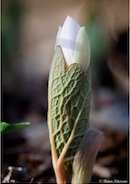 A member of the Papaveraceae family and a relative of the poppy, Sanguinaria canadensis grows wild in the rich, moist soil of shady woodlands throughout the eastern half of North America. Between March and May, the bloodroot plant produces a single flower bud tucked neatly inside a leaf. Although the flower’s display is fleeting, lasting only a day or two, it is large for such an early bloomer, reaching up to 2 inches wide. The white flower most often has eight petals, but sometimes up to 12. Larger petals alternate with smaller ones, giving the bloom a somewhat square outline. If you were to cut the flower in half at any spot, its two halves would be perfectly symmetrical. Even after its flower disappears, bloodroot’s unevenly scalloped, waxy gray-green leaf is easy to spot since it continues to develop into June, and may reach 8 inches wide on a 12-inch stem.
A member of the Papaveraceae family and a relative of the poppy, Sanguinaria canadensis grows wild in the rich, moist soil of shady woodlands throughout the eastern half of North America. Between March and May, the bloodroot plant produces a single flower bud tucked neatly inside a leaf. Although the flower’s display is fleeting, lasting only a day or two, it is large for such an early bloomer, reaching up to 2 inches wide. The white flower most often has eight petals, but sometimes up to 12. Larger petals alternate with smaller ones, giving the bloom a somewhat square outline. If you were to cut the flower in half at any spot, its two halves would be perfectly symmetrical. Even after its flower disappears, bloodroot’s unevenly scalloped, waxy gray-green leaf is easy to spot since it continues to develop into June, and may reach 8 inches wide on a 12-inch stem.
Spring Ephemeral
Bloodroot is a spring ephemeral wildflower, meaning that the plant emerges early in the season, quickly flowers and fruits, then withers away leaving no trace above the ground. Most of the plant’s growth occurs before the 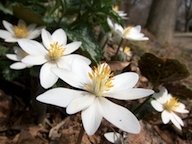 forest trees develop their canopy and shade the ground. Bloodroot’s leaves persist a little longer than its flowers, but they too are gone by early summer. During its short growing season, however, the leaf photosynthesizes, storing energy in the rhizome to develop a new leaf and bud which will emerge the following year. Over years, the rhizomes expand and can form large colonies.
forest trees develop their canopy and shade the ground. Bloodroot’s leaves persist a little longer than its flowers, but they too are gone by early summer. During its short growing season, however, the leaf photosynthesizes, storing energy in the rhizome to develop a new leaf and bud which will emerge the following year. Over years, the rhizomes expand and can form large colonies.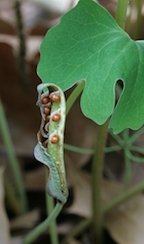 Reproduction
Reproduction
Although the bloodroot flower produces no nectar, its bright yellow stamens and white petals trick insects into cross-pollinating one plant with another. The bloodroot even has a back-up pollination plan: if the spring weather is too cold for insects, the stamens wither and collapse around the stigma, self-pollinating the plant. No matter the climatic conditions in which it grows, the bloodroot maximizes its ability to set seed.
After the flower’s petals fall, the female part of the plant develops into seeds encased in long, slender pods. Bloodroot belongs to a group of plants that rely on a dispersal mechanism called myrmecochory -- performed by ants -- to spread its seeds. The plant’s dark seeds contain an elaiosome, a fleshy structure rich in oils attractive to ants. After the ants carry away the seeds to eat the elaisomes, they discard the seeds in their nest debris, giving the bloodroot a perfect spot in which to germinate in a new location.
Historical Uses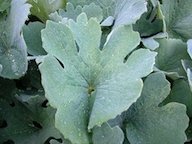
Bloodroot is not the plant’s only nickname; early American settlers also called it Indian paint, white puccoon, red puccoon, corn root, pain ease, red root, snake bite, sweet slumber, tatterwort and tumeric. The Virginian Indian name for bloodroot was “pokan,” referring to any red-juiced plant used for stain. The poisonous root contains alkaloids closely related to morphine, and was employed by Native Americans as both an internal and external treatment for a variety of ailments. The Tuscarora tribe used bloodroot as a tool of divination. The Omaha-Poncas used it as a love charm, believing that if a young man stained his palm with the red dye, any woman who shook his hand would be willing to marry him. Captain John Smith observed that the women of the Chesapeake Bay tribes used the red juice to adorn their bodies. The early settlers adopted bloodroot’s use as a fabric dye, adding oak bark whose tannin helped set the color.
Culture
Bloodroot is hardy in zones 4 through 9, and requires a well-drained location and moist, fertile soil. The orange-colored rhizomes will slowly spread in a woodland or other shady spot, and can eventually 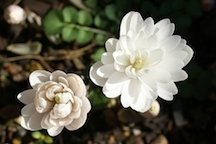 grow into a large colony. You can sow seeds in spring or fall. If you wish to make new plants, divide the roots immediately after the plant finishes flowering.
grow into a large colony. You can sow seeds in spring or fall. If you wish to make new plants, divide the roots immediately after the plant finishes flowering.
A double-flowered cultivar of the plant, S. canadensis f. multiplex or “Flore Pleno” is a desirable choice for spring bloom in shady gardens because its spectacular flowers last longer than those of the species. The double-flowering type is sterile; because it does not set seed it must be propagated by rhizome division.
Warning: All parts of the bloodroot plant are poisonous if ingested and can cause a skin irritation similar to poison ivy.
Images:
Thumbnail photo by Rob Ireton
Bloodroot in bud by Gordilly
Bloodroot colony by beautifulcataya
Bloodroot seeds by cotinus
Bloodroot leaf by Tie Guy II
Double-flowered bloodroot by Sericea
(Editor's Note: This article was originally published on April 29, 2011. Your comments are welcome, but please be aware that authors of previously published articles may not be able to respond to your questions.)
Copyright © www.100flowers.win Botanic Garden All Rights Reserved